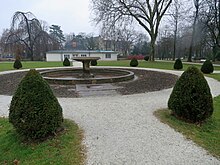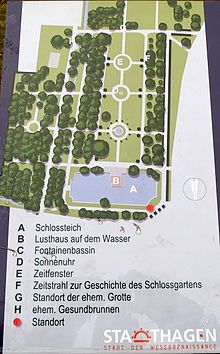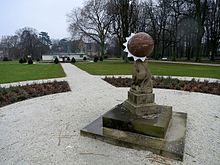Stadtgarten Stadthagen
The Stadtgarten Stadthagen - it is located south of the Stadthagen Castle in Lower Saxony - has an eventful history that goes back to the Renaissance . For centuries it was a stately pleasure garden with a fountain, a pleasure house over the pond and a grotto . But in the early days it also served as a kitchen garden with its large fruit trees and vegetables. In the 18th century it was redesigned in baroque style and in the 19th century it was partially leased to the citizens of Stadthagen. In the 1960s it was reconstructed as a baroque garden.
history
The Stadtgarten Stadthagen looks back on almost 500 years of history; In 1919, a princely palace garden of the Renaissance became a bourgeois city garden, which has been redesigned into a baroque complex for half a century.
Originated in the Renaissance
Most likely, the northern part of the garden was created as a palace garden, which was located south of the ramparts at that time, after the moated castle was converted into the present-day Renaissance palace just north of it. Count Otto IV. Von Holstein-Schaumburg created this befitting residence, which became the model for many buildings of the Weser Renaissance . Later (1714) there is a report of a fountain in the castle park, on which the following text was written: “By God's grace; Otto Grawe von Holstein, Schaumburg, Sternberge, Herr zu Gemen, Anno 1573 ” . Back in the 16th century, most of the palace gardens served as a kitchen garden to feed the palace population; there were fruit trees, berry bushes, and cabbage and vegetables were grown.
After Prince Ernst von Holstein-Schaumburg (1569–1622) moved his residence to Bückeburg in 1607 , his widow Hedwig (1569–1644) moved into Stadthagen Castle in 1622 as a retirement home. Forty years after her death, the palace garden was mentioned again in an inventory. Herbs and flowers, such as: B. Tulips, mentioned or lavender borders and many pots with carnations listed.
Redesign in the baroque style
After Johanna Sophie Countess von Schaumburg-Lippe (1677–1743) had been awarded Stadthagen through her divorce process in 1714, she returned to Stadthagen, her widow's residence, from England after the death of her husband in 1728 and began redesigning the complex. Her impressions gained in Hanover and England probably inspired her to redesign the palace garden in a baroque style. Even a labyrinth of red and hornbeam hedges was created in the southern part in front of the grotto. And in 1734 a healing spring was discovered near the bridge over the Mühlenbach, which was also to play an important role for a few decades, as a result of which Stadthagen almost became a spa. A small health resort with a bathhouse was created. One drank the healing water and bathed in it. But it wasn't a great success, so in 1819 it was leased to a former officer named Förster, who ran it together with an inn.
Lease to citizens
When parts of the palace garden were leased to citizens of Stadthagen from 1791, the structures of the baroque garden were gradually lost. That only changed again in 1875, when the palace was expanded as a hereditary prince's residence and the garden became a palace park again. A castle administration was installed again and the bathhouse, which had been built in the meantime near the healing spring, was converted into a gardener's house. The castle administrator moved into the thriving guest and dance venue "Försters Brunnen".
Public ownership and reconstruction of the park
After the First World War with its social and political consequences - the revolution and the Weimar Republic - the palace gardens became the Stadtgarten Stadthagen in 1919. But it was only after the Second World War that the reconstruction as a baroque garden was approached. The so-called "Houpeplan" from 1784 served as a model.
Nowadays, this city garden is an attractive complex in the south of the castle, which serves as the tax office. Together with the castle park, the city garden supplements the green areas of the district town, which are former ramparts around the old town, very advantageously. The Lusthaus am Teich, which serves as a café, had to be renovated in 2017 because it no longer met modern requirements.
literature
- Albrecht Wehling: Chronicle of the city Stadthagen. Stadthagen then and now. From the history of the city of Stadthagen. Magdeburg 1932.
- Friedrich Bartels: Stadthagen - then and now. Historical working group for Schaumburg, Rinteln 1972.
Web links
- stadthagen.de - Website of the district town of Stadthagen
- weserrenaissance-stadthagen.de - Information on art and artists of the Renaissance in Stadthagen
Coordinates: 52 ° 19 ′ 10.8 " N , 9 ° 12 ′ 19.7" E




